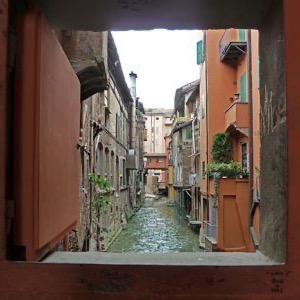Bologna is a city full of charm: here's how to visit it in one day and on foot, alone or in company.
I only had one day to visit Bologna nor the slightest organization for places to see. Nevertheless, on this tour I will make you discover that it is possible to know and fall in love with a city by spending only a few hours.

Leaving the Central Station I headed towards Viale Pietramellara, where I found a gallery with shops and bars. The bookshop at the end of the path immediately caught my attention as I needed to orient myself in a city that has almost 400.000 inhabitants.
Here I found one small guide for 3 euros which was fundamental for my travels, together with the tips given to me by the shop assistant.
Bologna walking tour
I headed straight up Independence Street, one of the main avenues of the city, crossed by the typical Bolognese arcades under whose arches there are endless rows of shops and bars. Crossing the avenue as soon as you arrive and knowing you have just under a day is really deleterious but inevitable, then imagine if it is the sales period. So, after wasting an hour between discounts, I went straight on like a racehorse with blinders to my goal. In fact, along Via Dell'Indipendenza you can reach the famous one in less than 10 minutes on foot Piazza Del Nettuno.
The square was born around 1565, with the demolition of a block between the Palazzo del Podestà and the Palazzo Re Enzo. At the center of the square stands what is now one of the symbols of Bologna, the Neptune statue, a splendid fountain built by the Flemish sculptor Giambologna. Paradoxically, it is the square that owes its name to the statue, built a few years earlier, in 1563.

This is not the only curiosity linked to the "Giant" of Bologna: the trident held by the god has become the trademark of an ancient Bologna car manufacturer, Maserati.
Not only that, the inscription "Populi commodo" placed on one side of the marble basin means "for the use of the people". And the Bolognese had no doubts about its practical purpose: it is said that the local women gathered there to wash the laundry and the vegetables in the fountain. Only a ban in 1588 managed to ban the use of the "wash house".
Piazza Maggiore
From Piazza del Nettuno what will catch your attention is Piazza Maggiore. The medieval palaces that surround it and the Basilica of San Petronio, dedicated to the patron saint of the city. Begun in 1390, its dimensions should have exceeded those of St. Peter's Basilica in the Vatican. The works were therefore interrupted by the Papal State. The Basilica still appears unfinished in the facade and in the side aisles. It will not be the largest basilica in the world but it is still the sixth largest in Europe.

At the foot of the Palazzo del Podestà, in front of the Basilica, there is the Bologna Welcome where I bought the ticket to visit the Tower of the Asinelli. The full price is € 5,00 and you go up in groups at intervals of time. Before heading to Via Rizzoli, I'll tell you a curiosity about this building: if you whisper in a corner of the internal colonnade supporting the tower, whoever is in the opposite corner will hear your voice perfectly.
At the end of Via Rizzoli, in the heart of Ravegnana square, I see the most famous towers of Bologna: the Tower of the Asinelli and Garisenda Tower. Initially built with a defensive function, they then became a symbol of the prestige of the Bolognese families. The first, 97 meters high, is the only one that can be visited, thanks to the internal steps (498) that lead to the top. From here you can enjoy a strategic view over the red roofs typical of Bolognese buildings, the medieval palaces and the numerous towers (23). In fact, Bologna as well as the learned, the fat and the red is also nicknamed the "turrita".
Behind the towers stands the Church of Saints Bartolomeo and Gaetano and in front of it the statue dedicated to San Petronio.
From here begins my tour through the streets of Bologna to discover palaces and towers. From Via Rizzoli I entered one of the pedestrian streets in front of me without a precise destination and instead I discovered via Altabella where there are two towers, the Azzoguidi (60 meters) and the Uguzzoni that open the way to another high tower 59 meters, the Tower of Prendiparte or the "Coronata", once the seat of the Archbishopric's prisons.
The streets of Bologna
I continue on, getting lost in the narrow streets of Bologna that line via Indipendenza. From Via Oberdan to Via Marsala I find myself on the small but famous one via Piella. Famous because here is the famous window overlooking the Moline canal, a stretch of the Reno Canal. This suggestive corner is called the “little Venice” because of its similarity with the canals of the lagoon city.

Have you seen how much can be done in one day? The project was made much easier by my moving around on my own. But with a little organization, unlike what I did, a group tour will surely be fun and enrich you even more.


























